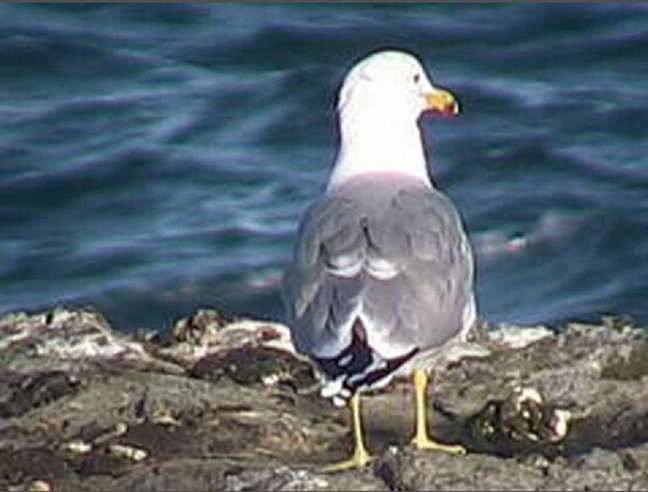A photo of the rare second year Glaucous Gull on the right, Western Gull on the left. Photo March 8, 2009 by Ryan This is only the third record for this area in the Rocky Point Bird Observatory records.
This is only the third record for this area in the Rocky Point Bird Observatory records.

Probable identification of the white gull on the left is the immature Glaucous gull. The gull on the right is an immature Glaucous-winged gull (photo 21st Dec 2005..camera 5 by Pam Birley)
To the left: This is a tentative identification. If it is correct, according to David Allinson of the Rocky Point Bird Observatory, ” this probably represents only the second record for Glaucous Gull (a 1st winter bird) for Rocky Point’s checklist (and a first for Race Rocks too!). The big head, the large bubble-gum pink dark-tipped bill, and white head and body (at least what can be seen) seems to be diagnostic.
However, to be cautious I should only say probable as we cannot see all of the bird.”
To the left: This is a tentative identification. If it is correct, according to David Allinson of the Rocky Point Bird Observatory, ” this probably represents only the second record for Glaucous Gull (a 1st winter bird) for Rocky Point’s checklist (and a first for Race Rocks too!). The big head, the large bubble-gum pink dark-tipped bill, and white head and body (at least what can be seen) seems to be diagnostic.
However, to be cautious I should only say probable as we cannot see all of the bird.”This is one of the largest species of gull. It can be up to 66-81 cm. in length. It nests on the tundra, and the range is circumpolar.It moves South in winter but only small numbers reach as far as the Pacific Northwest.” |
Domain Eukarya
Kingdom Animalia
Phylum Chordata
Sub-Phylum Vertebrata
Class Aves
Order Charadriiformes
Family Laridae
Genus Larus
Species hyperboreus
Common Name: Glaucous Gull


























